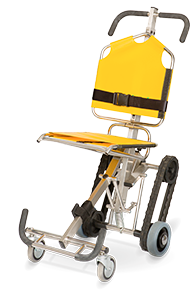Evacuation chairs provide an efficient, safe, and comfortable means of evacuating an individual that is mobility-impaired in the event of an emergency. You may also see evacuation chairs being referred to as; stairway evacuation chairs, fire evacuation chairs, evacuation chairs or disabled evacuation chairs.

An evacuation chair can aid a diverse range of people that cannot evacuate a building without some assistance. An individual may be incapable of evacuating without assistance due to injury, disability, pregnancy and many other medical conditions that can hinder their ability to move quickly in an emergency.
Are Evacuation Chairs a Legal Requirement?
There is currently no legal requirement for an organisation to provide evacuation chairs, the most relevant piece of legislation is the Regulatory Reform (Fire Safety) Order 2005 (RRO).
Within the RRO, it states that, after revising the findings of a fire risk assessment, the ‘responsible person’ on the premises must ‘consider anybody who may be especially at risk’ and act to protect these individuals as best they can. For example, somebody with a physical disability.
Therefore, government guidelines concur that where evacuation chairs are the preferred method of escape, the responsible person on the premises will provide them.
How do Evacuation Chairs Work?
Fire evacuations chairs are made from a light but extremely durable material, making them both manoeuvrable and robust.
On level ground they can be used as a normal wheelchair, however, when going downstairs, the tracks attached to the chair are deployed creating a bridge and friction between the steps. This dramatically reduces the speed of descent, allowing for a safe and controlled escape.
When not in use, the evacuation chair can be folded flat and secured neatly on a wall or stored within a specially designed unit.
Do I need an Evacuation Chair?
If you are recognised as the ‘responsible person’ on your premises, it is up to you to perform a fire risk assessment, create an emergency evacuation plan based on your findings and implement precautions accordingly. This includes providing a viable means of escape for people with a physical disability.
In 2021 it was believed there are just over 14 million disabled people in the UK (Scope), making up 19% of working-aged adults. This equates to roughly 1 in 5 people and therefore, there is a high chance that one of your visitors or employees will require the assistance of an evacuation chair in the event of an emergency.
How many Evacuation Chairs do I need?
The general rule of thumb is ‘ONE chair on ONE floor serves ONE person’. However, it can become very expensive to place a chair on every floor which is why conducting a fire safety assessment is so important.
You should place evacuation chairs in the most logical and appropriate areas, based on the current level of fire safety, the building layout and acknowledging individual needs learned from Personal Emergency Evacuation Plans (PEEP).
Remember that evacuation chairs are a means by which a mobility-impaired person may escape, and not a replacement for a well-designed evacuation plan. Regular training for the use of fire evacuation chairs should be implemented into your fire drills.
Fire Evacuation Chair Training
Operatives using the evacuation chair must be able to set them up, and in the event of an emergency, do so under pressure. They must know the chair balance points, how to check the person sitting in the chair is comfortable and secure, how to correctly position it on stairs and how to maintain the correct posture when using the chair.Personal Emergency
Initially, it is important that the selected staff undergo a training session with a qualified trainer who will cover; chair familiarisation, manual handling, chair use, transferring an evacuee from a wheelchair to an evacuation chair and then a practical assessment to test their knowledge.
Once fully trained, refresher training should be incorporated into your regular fire drills, this will ensure they are fully prepared should an emergency arise.
How often should an Evacuation Chair be serviced?
With equipment designed to protect human life, it is imperative that it remains in optimum working condition. If not maintained, it poses an increased risk to both clients and operators in the event of an emergency.
One of the leading evacuation chair manufactures Evac+Chair recommend that having your chair serviced annually will ensure the effectiveness of the equipment in the long term. They also state that the rubber tracks should be replaced every 5 years as they may wear and perish over time.
Don’t Take the Risk
Regardless of whether or not evacuation chairs are a legal requirement, it is extremely important to ensure the safety or employees, customers and visitors in the event of an emergency. Fire evacuation chairs can save lives and you as a business owner have a responsibility to ensure that you are prepared to do so.
How can we help?
We get that regulations can be hard to get your head around, knowing the different legislation or just staying on top of changes, there’s lots to get to grips with – we are here to help to the load off you. We’ll equip you with all the knowledge you need to be able to produce your own documentation and support you with managing the process as your business changes and grows.
Our Health & Safety experts can visit your business, identify any gaps in your current manual handling processes, and advise on any recommendations.
If you would like tailored advice for your workplace, want to book training for your business or organisation, then get in touch with Train Direct.
tel. 0330 223 5586,
email. info@traindirect.co.uk
or complete the form on our homepage to request a call back.
























Comentários